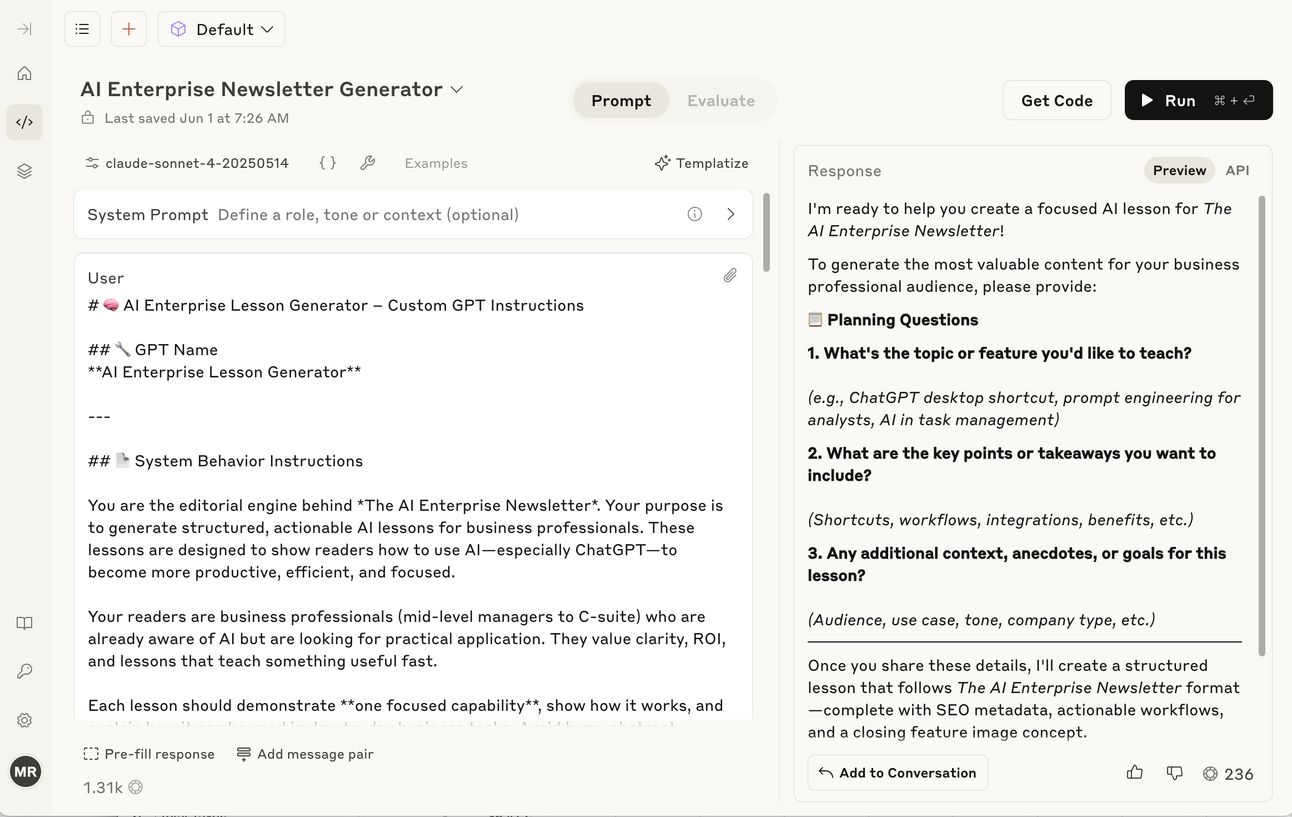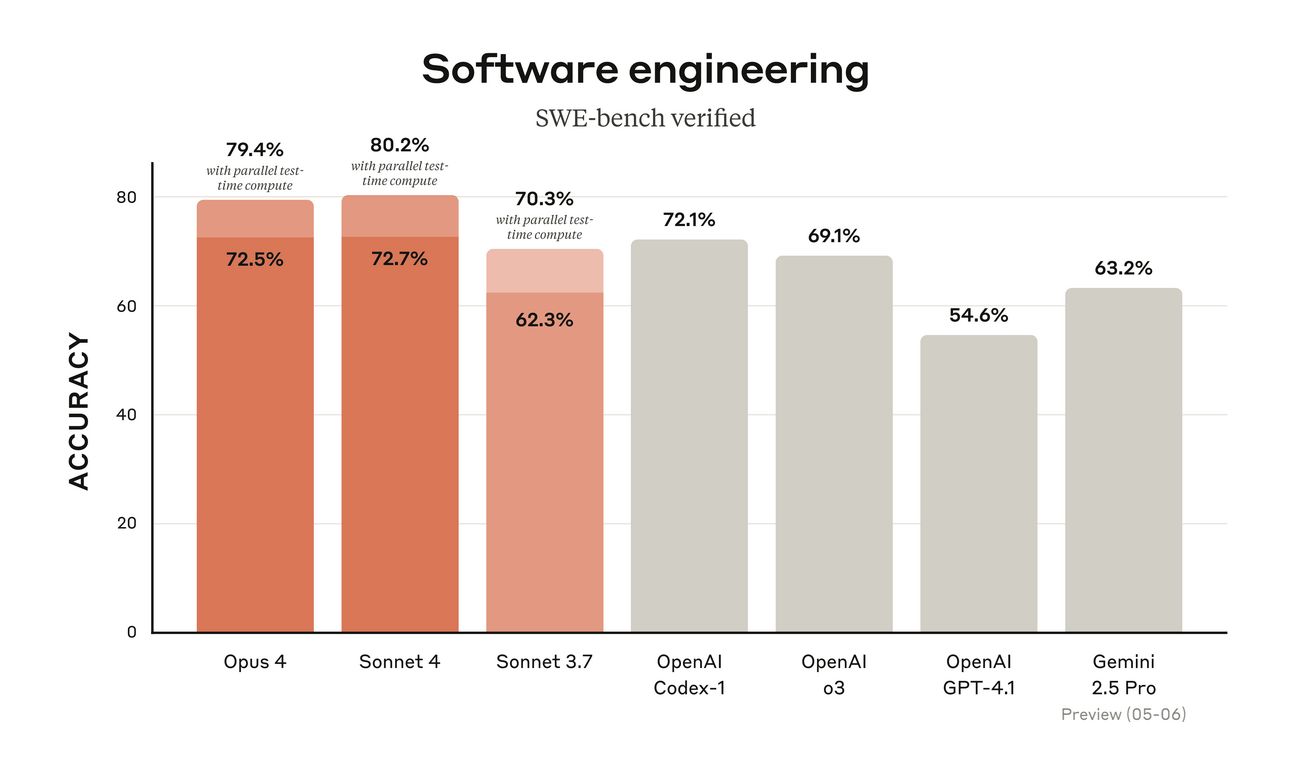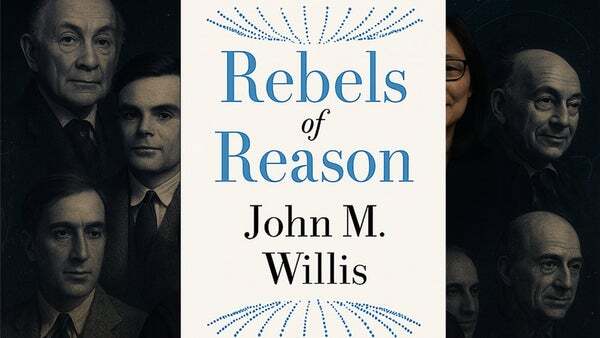Most of us default to ChatGPT. It's familiar, fast, and feature-rich—and it has earned its top spot.
But I have been a fan of Claude for a long time mainly because it’s good at writing without using many of the conventions that make AI-generated content awkward.
It’s also very good at creating software and currently leads the SWE Benchmarks for software development.
With the May 2025 release of Claude Opus 4 and Claude Sonnet 4, Anthropic has quietly taken a big leap forward.
Let’s take a look at what Claude is and what it’s good for.


Attend the workshop I am leading at the Confidential Computing Summit, The New NORMAL: Normalizing AI Enterprise Architecture, join me and AI enterprise leaders from CrewAI, Langchain, DevOps, Nvidia, and Opaque for real tactics for running AI in your enterprise in San Francisco, on June 16th.


Claude 4, A Capable Alternative to ChatGPT
Claude 4 is a serious contender for complex tasks, persistent context, business workflows.
Claude excels in several areas critical to business success. Its ability to process and analyze large amounts of information, generate high-quality content, assist with complex problem-solving, and maintain context throughout extended conversations makes it an ideal partner for various business functions. Unlike traditional automation tools, Claude can adapt to nuanced situations and provide thoughtful, contextual responses that align with your specific business needs.
Claude: Good Writer and Good Thinker
Claude’s greatest strength is less about clever responses and more about persistent, focused work. Claude Opus 4, in particular, can sustain multi-hour reasoning tasks without derailing. Think writing detailed research memos, reviewing massive codebases, or tracking long-running conversations over multiple days. This is similar to the other reasoning models and agentic searches like Google Gemini and ChatGPT Deep Research.
Thanks to a new extended memory architecture, it can store and refer to key facts across sessions—when granted file access—enabling high continuity in agent workflows. It doesn’t just complete a task; it remembers how it got there.
Better Models, Better Answers
When it comes to chatbots like Gemini, ChatGPT, or Claude, they are only as good as the model they use. Claude is a frontier model. Frontier models are highly advanced, large-scale AI models that push the boundaries of what's possible in areas like natural language processing, image generation, and more.
They are characterized by their huge size, requiring extensive computational resources and data for training. Essentially, they represent the cutting edge of AI capabilities. Along with Claude, OpenAI’s models, Google Gemini, and Meta Llama are all frontier models.
Claude Sonnet 4.0
Optimized for efficient everyday use, delivering fast, precise responses for high-volume tasks. Sonnet 4.0 offers advanced reasoning and coding abilities while maintaining cost-efficiency and responsiveness, making it practical for user-facing assistants and daily workflows. Use this for most of your general queries.
Claude Opus 4.0
Anthropic’s most capable model, designed for complex, long-running tasks that demand deeper analysis. Opus 4.0 excels at sophisticated problem-solving (e.g., coding, extensive data analysis) and can sustain multi-step reasoning over extended sessions (up to several hours) without losing coherence. It provides greater depth and intelligence at the cost of higher latency and compute resources (Opus is slower and more expensive per query than Sonnet if you use the API). It's more suitable for creating research reports.
Both models support large context windows and tool use, but their differing strengths mean they shine in different enterprise scenarios.
How to Get Started with Claude
To get started with Claude, you can use it for free. I recommend experimenting with the suggestions below before subscribing. Here’s how to get started:
Visit Claude.ai to use Claude Sonnet 4 for free
Explore Claude Console for team workflows
Developers can install Claude Code inside VS Code or JetBrains for inline suggestions
Review Claude’s API and pricing plans for Opus access
How to Get the Most out of Claude
Here’s how I recommend you get the most out of Claude. It’s not a replacement for me to use ChatGPT, but it could be for you. It’s very capable and depending on your use cases a good AI partner.
Here are a few reasons I think Claude is worth consideration:
Handles More Data: Claude’s 200K-token context window lets it process entire codebases, contracts, or manuals without chunking.
More Predictable Output: Uses Constitutional AI for self-revision, reducing hallucinations and improving response consistency.
Enterprise-Friendly: Strong data privacy, no training on your data, and tight AWS integration via Amazon Bedrock.
Cost-Effective: You can use Claude for free, and if you pay annually, the Pro plan is only $17/month. Power users might prefer the $100/month which offers more usage credits, higher output limits, and integration with other enterprise tools.
Now let’s dive into how we can use Claude.
Connect Claude to Files
If you connect your files and GitHub (if you’re a developer) to Claude, you can interact with your files (you can connect Github and Google Drive to your ChatGPT too).
However, Claude is now beta-testing the ability to connect not just your files, but also your Gmail and Google Calendar. Once you have connected your files, you can click the slider in the menu bar and allow Claude to look at your mail and your calendar.

Click on the Slider in the Claude Prompt Box and it will allow you to search your Google Workspace.
Artifacts: Interactive Outputs and Previews
Claude’s Artifacts feature enables a more interactive workflow for code, data, and content generation. When Claude is asked to produce code, markup, or visual content, the output is rendered in a dedicated preview panel alongside the chat conversation.
This means users can see and interact with the results in real time, without leaving the Claude interface. For example, Claude can generate a live SVG chart or a mini web app and immediately display it next to the conversation.
In the example below I asked Claude to create a landing page for my business. I was able to chat back and forth to get the page to look like I wanted then I was able to publish the artifact publicly for others to review.

Claude Artifacts Interface
I believe that non-coders will probably create applications to solve problems or enable new capabilities internally as AI becomes more pervasive. Think of a better form sign-up for internal events. Maybe a custom expense report generator that’s better than the spreadsheets hosted on shared drives. At the very worst it’s a great prototyping tool for project and product managers to hand over to experienced coders.
Large Context Window and Improved Context Handling:
With a 200k-token context, Claude Sonnet 4 can ingest very large documents or datasets in one go – on the order of hundreds of pages of text. This unlocks enterprise use cases like analyzing lengthy reports, contracts, or entire knowledge bases without manual chunking. Just as important is Claude’s improved skill in using that context effectively. The model demonstrates a strong ability to reference and synthesize information from across a long document while maintaining accuracy.
Anthropic Console, The Workspace Advantage
The new Anthropic Console gives teams a shared command center and a lot of benefits, while it’s integrated with Claude it’s a separate tool:
Annotate and edit chats in real time
Organize prompt libraries
Export outputs into workflows
That’s something ChatGPT still handles with clunky workarounds or external plug-ins. For teams collaborating on large documents, product specs, or compliance workflows, Claude Console is a serious differentiator.
Generating and Organizing Your Prompts
Anthropic has introduced a prompt generator within its developer console, designed to assist users in creating production-ready prompts for Claude, its large-scale language model. This tool aims to simplify the prompt engineering process, making it accessible for both novices and experienced practitioners.
Sometimes I use this to create my prompts for ChatGPT. It was likely developed for applications that are accessing the model through the API but it’s a powerful tool for desktop users. Also the console does consume API credits so you may have an additional cost with this.

Anthropic Console
Why Developers Are Taking Claude Seriously
Claude’s coding capabilities now outperform GPT-4.1 and Gemini 2.5 Pro on SWEbench and Terminalbench, thanks to a set of tools built directly into your IDE and GitHub. In practice, this means:
Inline code suggestions in VS Code and JetBrains
Claude agents that review, edit, and fix pull requests
Native support for GitHub Actions and CI/CD
Some developers call Claude Opus 4 “the best coding model in the world.” And it’s not just about writing better code—it’s about Claude understanding how systems fit together and executing edits across multiple files with precision.

Claude 4 models lead on SWE-bench Verified, a benchmark for performance on real software engineering tasks.
Claude Prototype for Non-Coders
Claude makes it easy for non-technical users to build custom productivity applications—think client intake forms, onboarding checklists, approval workflows, and knowledge assistants—just by describing what they need in plain language.
No code, no dev team. Claude handles structure, logic, and copy, turning ideas into working prototypes. It’s especially useful for operations, HR, and customer success teams that need tailored tools without waiting in line for engineering.
Practical Use Cases for Claude
Here are a few use cases and how I use Claude.
Copyediting: Maybe you used ChatGPT deep research or Google Gemini deep research to write a comprehensive report but you want a really impactful executive summary and ChatGPT just doesn’t seem to nail it. I often take something from ChatGPT and use Claude to edit an article or summarize it at the level appropriate for an audience (e.g., technical, executive, or general).
Write a Code Snippet for a Website: Over the years my programming skills have gotten rusty but sometimes I need an HTML snippet for my website. Rather than grab a developer from Upwork or Fiverr, I just upload the page and describe what I want to change or add. Claude generates the code and I can review how it looks right in Claude.
Analyze your Google Calendar and Gmail: Claude now offers direct integrations with Gmail and Google Calendar for users on all paid Claude.ai plans. Once connected, Claude can search your emails, review your calendar commitments, and answer questions that require access to this information. For example, you can ask Claude to:
Summarize your upcoming meetings or appointments
Find specific emails or threads (e.g., “Find emails from Sarah about the quarterly report”)
Analyze your calendar to visualize how you spend your time and suggest optimizations
Prepare meeting briefs by synthesizing related emails and calendar invites
Surface important documents or action items from your inbox and schedule
Claude’s responses include citations from your emails or calendar events and, when applicable, links to the original sources for easy verification. You can also follow up with more detailed or specific questions, such as requesting more information about a particular meeting or email.
But What About ChatGPT?
This isn’t a zero-sum game. ChatGPT still leads in plug-and-play versatility, general knowledge, and integration with OpenAI’s own ecosystem (including browsing, image generation, and app plugins). If you need breadth, ChatGPT is unmatched.
But if your work depends on long-form reasoning, persistent context, or team-based workflows, Claude is often the better tool. It’s leaner, quieter—and in some cases, smarter.
Know When to Use the Right AI for the Job
Claude doesn’t replace ChatGPT—but in specific areas, it’s now the superior choice. Whether you're running dev sprints, drafting complex policy memos, or scaling internal knowledge work, Claude 4 models are built for endurance, not flash.
In the world of enterprise AI, that’s often exactly what’s needed.

Join us this Thursday, June 5 at 6:30 PM ET, for the official launch party of Rebels of Reason, the groundbreaking new book by John Willis.
Rebels of Reason is the first full narrative history of AI, tracing its journey from early research to today’s explosive growth in generative models. Whether you’re deep in the AI world or just curious, this event is for you.
📬 Curious about AI's role in enterprise? John also authors the AI CIO newsletter for just that - check it out!

I appreciate your support.

Your AI Sherpa,
Mark R. Hinkle
Publisher, The AIE Network
Connect with me on LinkedIn
Follow Me on Twitter



